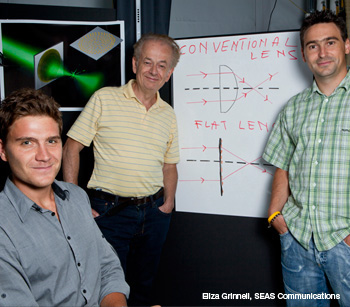
Left to right: Co-authors Francesco Aieta, Federico Capasso and Patrice Genevet.
By building a nanoscale array of tiny plasmonic antennas, researchers from the United States and Italian universities have created an ultrathin lens that focuses monochromatic infrared light without spherical aberration, astigmatism and coma (Nano Lett., doi: 10.1021/nl302516v).
In a broad sense, a traditional lens singlet focuses light by phase-shifting or time-delaying the propagating waves differently across the lens, said Federico Capasso, professor of applied physics at Harvard University (Cambridge, Mass.). The design of the new lens builds upon the team’s recent theoretical work on phase discontinuity in light propagation, which showed that a metallic surface patterned with subwavelength nanostructures could bend light (Science 334, 6054).
The researchers created a plasmonic “metasurface” consisting of an array of tiny antennas spaced 750 nm apart on a 60-nm-thick layer of gold. When the antennas absorb light from a diode laser emitting at the standard telecommunications frequency of 1,550 nm, electrons within the antennas oscillate and re-emit the light. The distribution of the phase shifts across the surface of the ultrathin lens results in a focusing of the light.
Theoretically, this proof-of-concept lens could focus visible light, but only for a single wavelength. (A visible-light lens would probably need to be made of silver or indium tin oxide.) The team is exploring lens designs for focusing broadband light without chromatic aberration. Many possible applications of the thin lens, from consumer electronics to biomedical imaging, would require broadband light. In addition, the researchers need to boost the focusing efficiency of the lens from 1 percent to 10 percent or higher by shrinking the antenna spacing and using different materials.
The study’s lead author, Francesco Aieta, is a visiting graduate student from the Università Politecnica delle Marche in Italy. Other team members are from Texas A&M University (U.S.A.) and the Università degli Studi di Trento (Italy).
